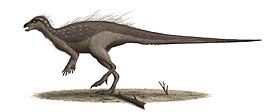Parksosaurus
Stratigrafický výskyt: Svrchní křída, asi před 70 miliony let | |
|---|---|
(c) I, Steveoc 86, CC BY 2.5 Parksosaurus warreni | |
| Vědecká klasifikace | |
| Říše | živočichové (Animalia) |
| Kmen | strunatci (Chordata) |
| Třída | plazi (Sauropsida) |
| Nadřád | dinosauři (Dinosauria) |
| Řád | ptakopánví (Ornithischia) |
| Podřád | Cerapoda |
| Infrařád | Ornithopoda |
| Čeleď | Hypsilophodontidae nebo Parksosauridae |
| Rod | Parksosaurus C. M. Sternberg, 1937 |
| Některá data mohou pocházet z datové položky. | |
Parksosaurus („ještěr Williama Parkse“) byl rod menšího ornitopodního dinosaura, žijícího na území západu Severní Ameriky v období pozdní křídy.[1][2]
Popis
Parksosaurus byl až 2,5 m dlouhý[3] a kolem 45 kg vážící[4] býložravý dinosaurus. Byl to dynamicky stavěný, po dvou nohách se pohybující ornitopod. Tento poměrně primitivní zástupce infrařádu Iguanodontia poněkud připomínal známějšího a mnohem staršího hypsilofodona. Žil v období svrchní křídy, asi před 70 miliony let. Jeho fosilie byly objeveny v Kanadě (provincie Alberta). Zkameněliny postkraniální kostry a fragmentů lebky byly objeveny v sedimentech proslulého souvrství Horseshoe Canyon. Původně byl materiál v roce 1926 popsán jako Thescelosaurus, v roce 1937 jej pak paleontolog Charles M. Sternberg překlasifikoval jako samostatný rod a zvolil nové rodové jméno Parksosaurus.[5]
Paleoekologie
Tento malý dinosaurus zřejmě rychle běhal a možná byl schopen i vyhrabávání nor. Přední i zadní končetiny měl poměrně silné a robustní. Jeho čelisti byly zakončeny zobákem z rohoviny, který pomáhal ve zpracování tuhé vegetace. Parksosauři žili ve stejném prostředí jako mnozí rohatí a kachnozobí dinosauři, ankylosauři i teropodi.[6] Před velkými tyranosauridy (jako byl Albertosaurus a Daspletosaurus) se zřejmě zachraňovali útěkem. Parksosauři byli podle novějších objevů poměrně rozšířenou skupinou ornitopodů, jejich fosilie (resp. fosilie příbuzných druhů) již byly v podobě zubů objeveny například i v pozdně křídových vrstvách Mexika (souvrství Cerro del Pueblo).[7]
Série fosilních stop podobného dinosaura (možná právě parksosaura) byla objevena na území jihozápadní Alberty v sedimentech souvrství St. Mary River.[8]
Odkazy
Reference
- ↑ https://dinodata.de/animals/dinosaurs/pages_p/parksosaurus.php
- ↑ Hans-Dieter Sues, David C. Evans & Caleb M. Brown (2022). Anatomy of the neornithischian dinosaur Parksosaurus warreni from the Upper Cretaceous (lower Maastrichtian) Horseshoe Canyon Formation of Alberta, Canada. Cretaceous Research. 105369. doi: https://doi.org/10.1016/j.cretres.2022.105369
- ↑ Holtz, Thomas R., Jr.; Rey, Luis V. (2007). Dinosaurs: The Most Complete, Up-to-Date Encyclopedia for Dinosaur Lovers of All Ages (Aktualizovaný internetový dodatek, str. 43). New York: Random House. ISBN 978-0-375-82419-7.
- ↑ Paul, G. S. (2010). The Princeton Field Guide to Dinosaurs. Princeton University Press, str. 277 (anglicky)
- ↑ Sternberg, C. M. (1937). Classification of Thescelosaurus, with a description of a new species. Proceedings of the Geological Society of America. 1936: 375.
- ↑ http://www.dinochecker.com/dinosaurs/PARKSOSAURUS
- ↑ Héctor E. Rivera-Sylva, Eberhard Frey, Wolfgang Stinnesbeck, Natalia Amezcua & Diana Flores Huerta (2018). First occurrence of Parksosauridae in Mexico from the Cerro del Pueblo Formation (Late Cretaceous; Late Campanian) at Las Águilas, Coahuila [Primera localización de Parksosauridae en México en la Formación Cerro del Pueblo (Cretácico tardío; Campaniano tardío) en Las Águilas, Coahuila]. El Boletín de la Sociedad Geológica Mexicana 70(3): 779 ‒ 784. doi: http://dx.doi.org/10.18268/BSGM2018v70n3a10
- ↑ Donald M. Henderson, Benjamin Borkovic, Joseph Sanchez, and Amy L. Kowalchuk (2022). A busy time at the beach: multiple examples of gregarious dinosaur behaviour inferred from a set of trackways from the Late Cretaceous of Alberta, Canada. Canadian Journal of Earth Sciences (advance online publication). doi: https://doi.org/10.1139/cjes-2021-0069
Literatura
- Parks, William A. (1926). Thescelosaurus warreni, a new species of orthopodous dinosaur from the Edmonton Formation of Alberta. University of Toronto Studies (Geological Series). 21: 1–42.
Externí odkazy
 Obrázky, zvuky či videa k tématu Parksosaurus na Wikimedia Commons
Obrázky, zvuky či videa k tématu Parksosaurus na Wikimedia Commons - Informace na webu Prehistoric Wildlife[nedostupný zdroj] (anglicky)
- Profil taxonu na databázi Fossilworks Archivováno 29. 8. 2021 na Wayback Machine. (anglicky)
- SOCHA, Vladimír. Dinosaurus z roku Jaroslava Mareše. OSEL.cz [online]. 18. května 2022. Dostupné online. (česky)
Média použitá na této stránce
Autor:
- Information-silk.png: Mark James
- derivative work: KSiOM(Talk)
A tiny blue 'i' information icon converted from the Silk icon set at famfamfam.com
(c) I, Steveoc 86, CC BY 2.5
Parksosaurus warreni restoration,
- • Based proportionally on a skeletal diagram by Gregory S Paul. [1]
- • The skin details in this image are speculative but based loosely on related dinosaurs. Until recently most skin impressions from Ornithischians showed circular or polygonal scales but these were from larger hadrosaurs and ceratopsians. In 2009 the Heterodontosaur Tianyulong was described which shows filamentous quill like structures along its back and underside. [2] In 2014 Kulindadromeus was described and showed a mix of feather like structures and scales. [3]
- • The colours and/or patterns, as with nearly all reconstructions of prehistoric creatures, are speculative.
NOTE: I often update my images. If you want to have any of my images on a website, please (if possible) don’t host/save it to the website server. I’d prefer it if the image's Wikimedia URL is used. This means that if I update an image, it will be updated on the site as well. Thanks.
References
- ↑ Paul, G.S. , ed. (2000) The Scientific American Book of Dinosaurs, St. Martin's Press ISBN: 0-312-26226-4.
- ↑ Zheng, Xiao-Ting (19 March 2009). "An Early Cretaceous heterodontosaurid dinosaur with filamentous integumentary structures". Nature 458 (7236): 333–336. DOI:10.1038/nature07856. PMID 19295609.
- ↑ Godefroit, P., Sinitsa, S.M., Dhouailly, D., Bolotsky, Y.L., Sizov, A.V., McNamara, M.E., Benton, M.J., and Spagna, P. 2014. "A Jurassic ornithischian dinosaur from Siberia with both feathers and scales." Science, 345(6195): 451-455. Published 25 Jul 2014. doi:10.1126/science.1253351


